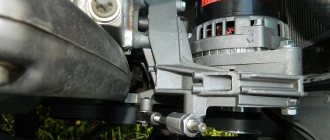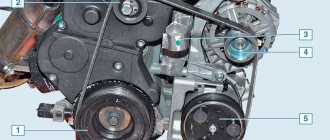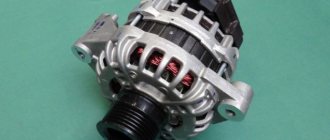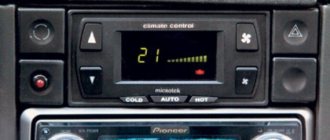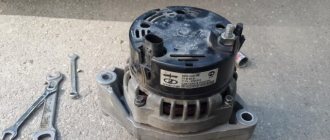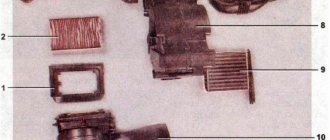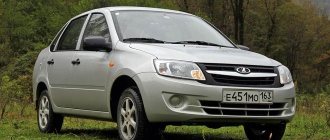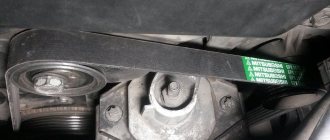To be honest, the Lada 4x4 is just a Niva. I'm generously sorry, but we simply cannot call her anything else. It was known to our ancestors under this name. Moreover, it was in 3-door form, with stamping and bumpers made of real metal. Let the ill-wishers scream that nothing has really changed at the Niva plant in 40 years, but the situation on the car market is such that many now pay more attention to their wallets than to dubious amenities and external graces, so Niva has everything chances of a second birth.
The fact is that no one else will offer you SUVs with such mobility capabilities and at such a price - neither in Russia nor abroad. In addition, Lada 4x4 has a chance to conquer the Western market, and in old Europe. And especially in Azerbaijan, and, therefore, there is something to talk about in this regard. The current generation almost entirely had foreign models as their first cars, so the overwhelming majority of them hardly understand what the Niva is. Although, to be honest, we haven’t talked to her for a long time. Well, but now let's talk closer.
Getting into this car, the first thing I had to remember was where the lever that opens the rear door is located. It is located to the left of the passenger seat. A little strange, to be honest, especially considering that the key for the rear door is different from the one used in the ignition. Those who are accustomed to opening the back door through the newfangled “kicks” with their feet under the rear bumper are unlikely to understand us; for a Lada 4×4, even the central locking is something cosmic.
By the way, the trunk still needs to be closed back. This will require - yes, that's right - slamming the back door. The spring that is attached to the lid is made specifically, so you can’t just let go of the back, you have to lower it with force. But the sound of a clap will make you sure that the door is definitely closed. And please, be careful - there may be a person standing nearby (a child, for example) who could accidentally grab the doorway.
Install an air conditioner on the field
It’s hot here, it’s depressing without air conditioning in the car. But I don’t want to switch to a foreign car again. Moreover, NIVA suits me.
I asked my friends to bring an air conditioner to NIVU, and they brought a “Hercules” that is universal for all cars. Universal, as it turned out later, because it cannot be installed on any car.
I’ll tell you in order all the rakes and how to get around them.
The choice to bet or not to bet (my opinion). Air conditioning is only for a short NIVA or CHEVY, definitely, the air conditioner takes a lot of power in the city cycle.
When purchasing, it is better to lay everything out on the counter or those. service and check for yourself what you are buying or what they are going to deliver to you. The kit should include:
- evaporator unit (if it is mounted in a heating system, then it is something like a stove radiator plus a control unit; if it is mounted as a separate unit, then the whole structure looks like a split system);
— bracket for installing the compressor;
— bracket for installing the indoor unit;
— emergency pressure valve;
— pulley fastening nut;
— a set of hoses (so that all this, on the table, is connected into a single chain);
Music in Niva
But who wants excellent quality, multi-channel, loud music? Everyone. But not for Niva buyers. All sorts of lordly manners such as multimedia (or even audio preparation, speaker mounts, etc.) are not provided. Want a treat for your ears? Implement it all yourself. As if sensing that some particularly spoiled drivers would still want to hear some tunes at all costs, as a gesture of goodwill, the manufacturer decided to provide a place for a radio in the center panel. Let’s say right away that the noise coming from the chassis will interfere with listening to the audio system if you install one. But first things first.
You are probably used to the fact that when you leave your car, the car itself turns off the light for you that you forgot to turn off. Or, at worst, it politely starts beeping that you forgot to do this. But this is Niva. Somehow we actually forgot to turn off the button responsible for the light - the result was, after some time, a completely dead battery. This machine has long been known as a product not for the lazy, and this also applies to small parts. Do not think that we strongly criticize the domestic model - rather, the reason for this is that we have been spoiled in recent years by the comfort and convenience of modern cars.
Lada 4×4, by the way, technically also does not stand still. For example, daytime running lights can light up on their own; when the engine is turned off, they also go out on their own. The steering wheel has become much lighter than on the old Nivas - no wonder, because the car now contains power steering.
Air conditioner for Lada Niva VAZ 21214
DESCRIPTION OF THE CLIMATE SYSTEM
The climate system is a combination of a heater and air conditioner that have a common air distribution and intake system with unified control and is designed to maintain a comfortable temperature at any time of the year in the range of up to 40°C.
Cooling is carried out by means of freon refrigeration equipment (air conditioner), built into the vehicle heating system (climate system heater) and connected to the vehicle components and parts by mounting and electrical elements (installation kit).
The heater can be either standard or original. The climate system operates in two main modes: cooling and heating.
When operating in maximum load mode, the air conditioner provides a decrease in the temperature in the cabin by 5°C...12°C relative to the outside air temperature, depending on the intensity of solar radiation, air humidity and the number of people in the cabin.
The air conditioner is a freon refrigeration machine driven by a car engine.
Niva cross-country ability
Let's talk about the vehicle's cross-country ability. The car is not afraid of a washed-out track, a grader with perpendicular ditches, or broken asphalt. If you even put all-season tires with a standard tread on the car, it will look like a clear winner compared to all other small or medium-sized crossovers. Ditches? Either along or across. Puddles? At least kilometres. A trip to the forest between the trees? It’s easy, and even protruding roots are not scary, as long as you don’t lose track of the steering wheel.
There were also trips through the forests near Tver, along country roads - wherever we had to wander around. And in these conditions the car could always only be remembered with a kind word. The car proved to everyone 40 years ago what it is capable of - a bunch of awards and prizes over 40 years only confirm this.
The number of videos on the Internet in which a car gets out of terrible mud or holes without any difficulties is simply off the charts, it’s hard to watch and not re-watch. In addition, SUVs are quite often constructed from Niva - in terms of price and quality, it has no equal. Especially in terms of price - in the current crisis conditions, for 500 thousand rubles you simply won’t find anything like it for trips to the forest, fishing and hunting, or off-road driving - even ATVs from the Middle Kingdom can cost more than a Niva.
Install an air conditioner on the field
Air conditioning for Niva 213-214 and Chevy-Niva or a new fan for Niva
Now we have the opportunity to equip the Niva 214 series with refrigeration equipment, or rather air conditioning, or install a new interior ventilation system on both Niva 2121 and Niva 213-14.
The climate system is a combination of a heater and air conditioner that have a common air distribution and intake system with a unified control and is designed to maintain a comfortable temperature at any time of the year in the range of up to +40°C and +50°C in a tropical version.
Cooling is carried out by means of freon refrigeration equipment (air conditioner), built into the vehicle heating system (climate system heater) and connected to the vehicle components and parts by mounting and electrical elements (installation kit).
The heater can be either standard or original. The climate system operates in three main modes: cooling, heating, air drying.
The latter mode provides for the operation of the air conditioner and heater simultaneously and allows, at high humidity in cool weather (0°C...+10°C), to get rid of fogging of the windows, while maintaining the set temperature in the cabin.
When operating in maximum load mode, the air conditioner provides a decrease in the temperature in the cabin by 5°C...12°C relative to the outside air temperature, depending on the intensity of solar radiation, air humidity and the number of people in the cabin.
The air conditioner is manufactured to order for Niva 214 series cars, as well as Chevrolet - Niva and is a freon refrigeration machine driven by the car engine.
New interior ventilation system for Niva:
Currently, we have begun to refine the interior ventilation system by installing another fan (more powerful) in the car, and moving it to the engine compartment, which has significantly reduced the noise from the operating fan in the car interior. At the same time, we seal the air supply pipes from leaks. It is no secret that the Niva suffers greatly from poor ventilation of the interior windows and often, once you get into the car after rain or snow, it is impossible to start driving without arming yourself with a rag or towel, and after about two more months of intensive operation of the heater fan, it begins to emit a heartbreaking squeal and cry asking to change it to a new one, which after the same time will squeal again, this is what made me pay attention to this drawback and the possibility of eliminating it., and you can see what happened in the photo.
Checkpoint in Niva
The travel of the gearshift knob, as in the old Niva models, is very small here. Even Moskvich is unlikely to compare. Shifts are carried out quickly and clearly, nothing is loose, but it doesn’t jam either - that’s nice. The clutch operation also did not cause any complaints, the left leg does not experience fatigue. Please note that we are trying to write the article in simple language, without using any abstruse language and all sorts of, you know, terms - this will make it easier for you to perceive and for us to convey your impressions of the car.
Driving on good asphalt was accompanied by some confusion of feelings - you were constantly expecting a catch - a car with such a short wheelbase and high seating position, in theory, should need constant steering. But nothing like that happened, and that’s nice. Let's even say more - other cars from AvtoVAZ are frankly inferior here.
The car, of course, does not have any special dynamics, although, to be honest, there is no desire to put much pressure on the accelerator pedal. The car cannot be quickly maneuvered due to, as already mentioned, a short wheelbase and high seating position. This is the first one. Turns must be taken carefully so as not to cause unnecessary roll.
Second. Having not the largest engine capacity, the Niva loves to eat gasoline. Moreover, the AI-95 brand is the manufacturer’s recommendation. Number of gears: 5 pieces.
And third. Having accelerated to 60 km/h, the car becomes very noisy. It may be a whistle, a hum, a howl - whatever you call it, but the noise from the chassis can be heard very clearly. Those who are new to driving Russian cars may think that the Niva is living its last minutes and is about to stall or fall apart. Thus, the manufacturer’s wisdom regarding unnecessary musical accompaniment was fully demonstrated; the audio system simply will not be heard. However, after accelerating to 100-100 km/h, a technological surprise awaits us - the transmission sound, which had been increasing until this time, suddenly becomes quieter.
All this happens regardless of the quality of the road surface.
Thanks for subscribing!
Perhaps the level of noise emitted corresponds to some loudness standards, but people who have been driving foreign cars for a long time try to run away from such audio delights like cockroaches. It takes a lot of effort to persuade them to stay and explain that this is not just a passenger car, but a rather complex mechanism containing a cunning chassis. Particularly smart comrades tend to pull all sorts of handles that lower gears and lock the differential, despite the fact that the label with their location is glued directly to the plastic casing.
However, let’s move on to happier things - namely, we’ll talk about the design of the Lada 4×4 all-wheel drive. This is a real ALL-wheel drive, the car uses all 4 wheels while driving, there are no clutches or other connected nonsense. As, in fact, not a shadow of any electronics capable of slowing down the rotation of the wheels. But there is a handle for a rigid differential lock, as well as a handle for engaging lower gears. In this case, there are no designations that could be used as a guide. The driver himself needs to figure out whether to help the car by turning on the off-road properties of the chassis or not. This is not some foreign car, you have to think about it!
Lada 4×4 will receive air conditioning and a number of attractive upgrades
On March 12, AVTOVAZ hosted the ceremonial release of the 2 millionth Lada 4×4 SUV, which began production under the name “Niva” back in 1977. After the official ceremony, journalists were told how this car will be modernized in the next few years - despite its advanced age, the legendary SUV will be significantly improved in the near future.
Off-road, the Lada 4×4 still gives a head start to many SUVs with a price several times higher, but until now it could not boast of comfort and silence on the asphalt...
According to the head of the Lada 4×4 project, Anatoly Moskaluk, the modernization is divided into three stages and will take place over the next three years. As previously reported, in 2013 it is planned to change the painting technology, after which the body's corrosion resistance will qualitatively increase, and in addition, SUVs can be painted in enamel with a metallic effect. For these purposes, in May 2013, the assembly will be stopped for 30 days to re-equip the painting line.
This is what the interior of a Lada 4×4 looks like now. Much more than its visual change, consumers are waiting for the appearance of air conditioning in it
In 2014, changes will be made to the interior and sound insulation will be improved, which will increase the aesthetic and practical comfort of the driver and passengers. Finally, in 2015, the car's chassis (that is, front and rear suspension) will be improved, as well as changes to the transmission. The Lada 4×4 project team considers this work as a stage of transition to the development of the new generation Lada 4×4 SUV. In addition, in 2015, the developers plan to introduce a version of the Lada 4×4 with air conditioning - it is clear that the appearance of a production car with this option is a very long-awaited event, but all design and technological work related to the introduction of an air conditioning compressor into the engine design will be completed no earlier than than by 2015.
Changes in appearance since production began in 1977 are minimal. For example, the rear part was changed only once, back in the early 90s, replacing the lights from the VAZ-2106 sedan with our own, vertical ones.
Let us remind you that Lada 4×4 has been modernized several times throughout the history of its production. The latest series of changes was very extensive; they began to be implemented in 2009, and they affected almost all systems: engine, transmission, brakes, steering, and interior. The appearance did not change much - only the sidelights, the design of the radiator grille and the external mirrors were changed. However, the updated Lada 4×4 compares favorably with its previous versions; noise and vibration are significantly reduced - we were able to drive an SUV with constant velocity joints (CV joints) in the transfer case design. When driving off-road, the car still shows miracles of cross-country ability, and on asphalt it has become noticeably quieter. It’s all the more pleasant to know that in a couple of years the Lada 4×4 will become an even more advanced, attractive and comfortable car. However, in December 2017 (approximate date) a completely new SUV will appear in the Lada model range...
Conditions for turning on the air conditioner on Niva Travel
There are a number of important conditions under which the compressor is guaranteed to turn on:
- On-board network voltage is no more than 16.5 Volts.
- The pressure in the system is normal.
- The throttle valve is open no more than 68%.
- More than 5 seconds have passed since the engine started.
- The compressor activation button has been pressed.
Attention! Controllers January 7.2, used for chip tuning of the VAZ 2123, do not take into account the refrigerant pressure sensor. The compressor will be turned on in any case, so you need to come up with protection so that the compressor does not turn on without oil, otherwise it will damage it!
That's all you need to know about the electrical part of the air conditioner in the Chevy Niva.
Installation process
Underhood
First we go under the car. Remove the engine protection and the generator belt. This belt will no longer be useful to us, as will the crankshaft pulley. Therefore, we remove it and install the one that comes with the kit. At first glance, it may seem that the original pulley fits well, but this is not so, because the alignment of the belt will be different, which will lead to its breakage.
Next, remove the reflective shield of the upper arm. A compressor will be mounted in its place. We fasten the mount, but do not forget to insert the bolt in advance, otherwise it will not work.
To install the belt from the kit, you will have to tinker, since it is not that big. We put it on all the rollers and pulleys, except the crankshaft. There we dress him halfway. Next, we turn the HF with the key and it is put in place. The tension is adjusted using the air conditioning compressor. After this, work in the engine compartment is completed. Next comes the most difficult part – the interior.
In the cabin
We remove the glove compartment and take out the injection ECU so that it is not in the way. After this, you need to remove the pipe that goes from the fan to the stove. We don't install it anymore, we can throw it away. An evaporator is installed instead. But to install it you will have to drill out the engine compartment. In addition, it is necessary to drill a hole in the floor to drain condensate.
In order for the stove and evaporator to be hermetically joined, the stove must be unscrewed from here:


